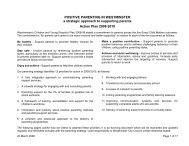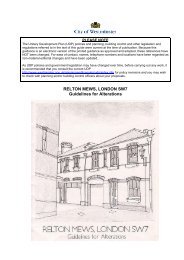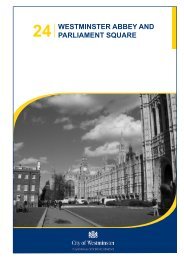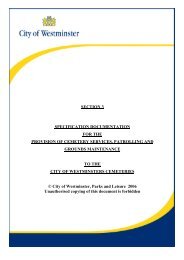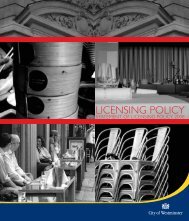Westminster Open Spaces Noise Study 2008 Final Report
Westminster Open Spaces Noise Study 2008 Final Report
Westminster Open Spaces Noise Study 2008 Final Report
- No tags were found...
Create successful ePaper yourself
Turn your PDF publications into a flip-book with our unique Google optimized e-Paper software.
<strong>Westminster</strong> <strong>Open</strong> <strong>Spaces</strong> <strong>Noise</strong><strong>Study</strong> <strong>2008</strong>: <strong>Final</strong> <strong>Report</strong>6. Discussion6.1.1 The lowest measured noise levels were observed towards the centre of the largest openspaces, these also had the highest tranquillity scores. <strong>Noise</strong> levels at the edges of the largesites were as high as many of the smaller sites.6.1.2 However, the overall correlation was weak (see Figure 5) across the full range of noiselevels within the open spaces surveyed. In the open spaces with moderate noise climates awide range of other experiential factors influence the respondents’ appreciation of thespace and its tranquillity.6.1.3 The visual factors that lie behind users tranquillity ratings show they are more or equallyimportant as audio factors. For example, only three of the top ten experiential factors thatare seen to add to tranquillity in Local Mixed Surface <strong>Spaces</strong> are factors of hearing, whilethe remaining seven are visual. On the other hand, noise related issues appear morefrequently among factors that are seen to detract from tranquillity. For example, eight out ofthe top ten factors that are seen to detract from tranquillity in Local Mixed Surface <strong>Spaces</strong>are noise related factors.6.1.4 Figure 6 explores the user’s sensitivity to noise levels more directly. Here, again with someexceptions, negative tranquillity scores around man-made noise (such as traffic andaircraft) were firstly fairly low and secondly not related to actual noise levels. This suggeststhat users are able to switch off less pleasant noise, possibly helped by the positive aspectsof the space, although mood and other tranquillity pillars will also come into this.6.1.5 It is considered no co-incidence that at three of the four sites which showed user dislike ofman-made noise, their overall tranquillity score was relatively or very low – even thoughthey were only in the medium noise range. This implies that mitigation of the most untranquilsituations in <strong>Westminster</strong>’s <strong>Open</strong> <strong>Spaces</strong> would involve noise related interventions,while enhancement of tranquillity in other (less noisy) spaces would require a more holisticapproach, giving visual, aural, sensual and even olfactory qualities more consideration.6.1.6 Whether there is a noise ‘tipping point’ for some open spaces, whereby they will alwaysstruggle to provide any degree of tranquillity without dealing with man-made noise wouldneed to be investigated further. However, it would make sense to reduce levels towards theaverage rear façade level of 55 dB L Aeq , (<strong>Westminster</strong> <strong>Noise</strong> Survey <strong>2008</strong> ) given the largenumber of residents, workers and visitors that do not enjoy access to a rear garden or rearof building space (see Figure 2). More importantly, the small number of areas where levelsare below this, should be suitably designated and protected6.1.7 The findings from this study therefore suggest that noise is the strongest link withtranquillity only in a limited number of spaces. When we compare findings across a widerrange of spaces, visual elements appear to be at least as important as noise elements. Theweightings in each typology are given below. These show the distinct experiential factorswhich are seen to affect tranquillity positively and negatively, in order of magnitude.Experiential factors with weightings below 1.0 in each typology have been disregarded inthis list, unless they are significantly different from the factors next to them, and it isconsidered that they could possibly be addressed specifically in any future mitigation orprotection strategies.Civic Public SpacePositive experiential factors, starting from most positive• Hearing water features• Seeing water featuresD121316/R1/0230Scott Wilson LtdMarch 2009





